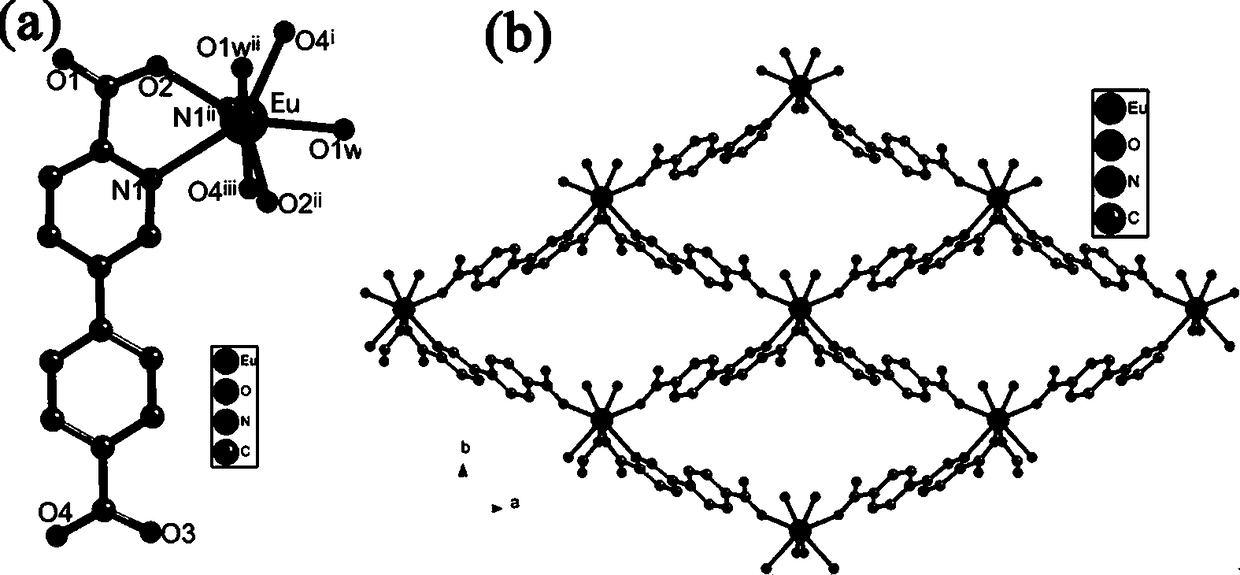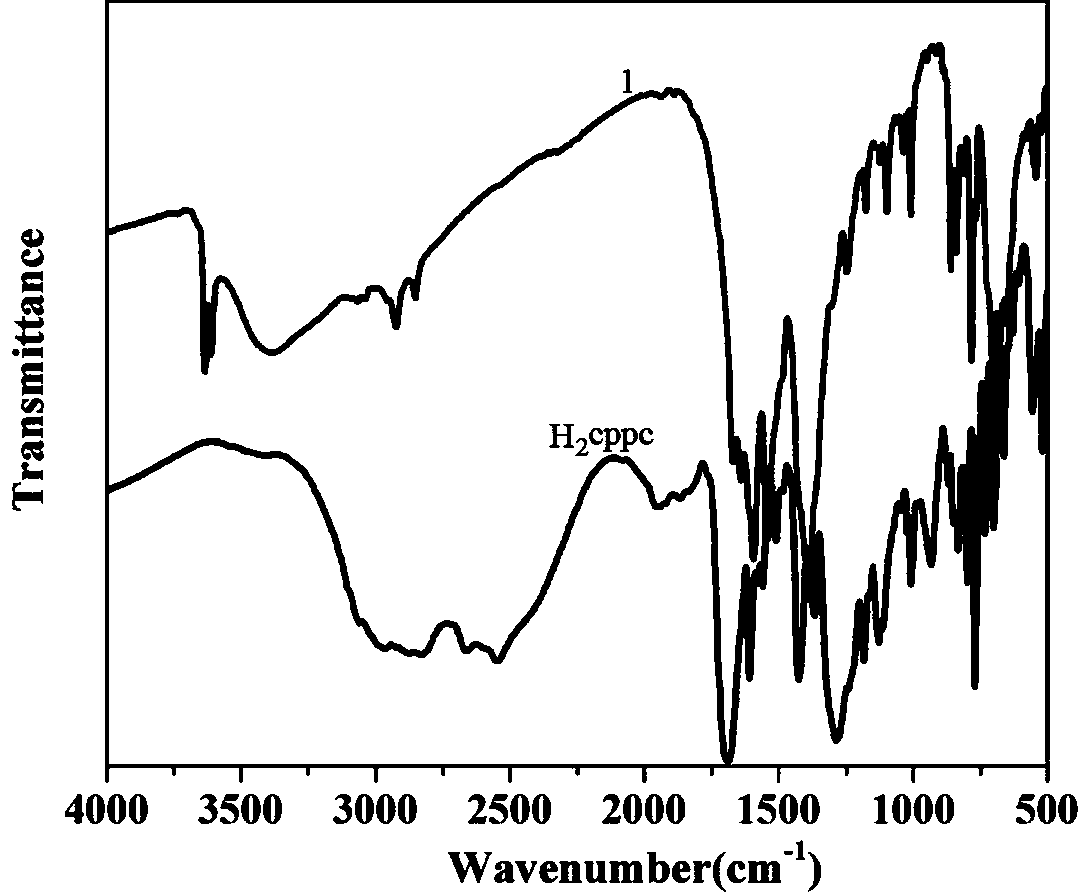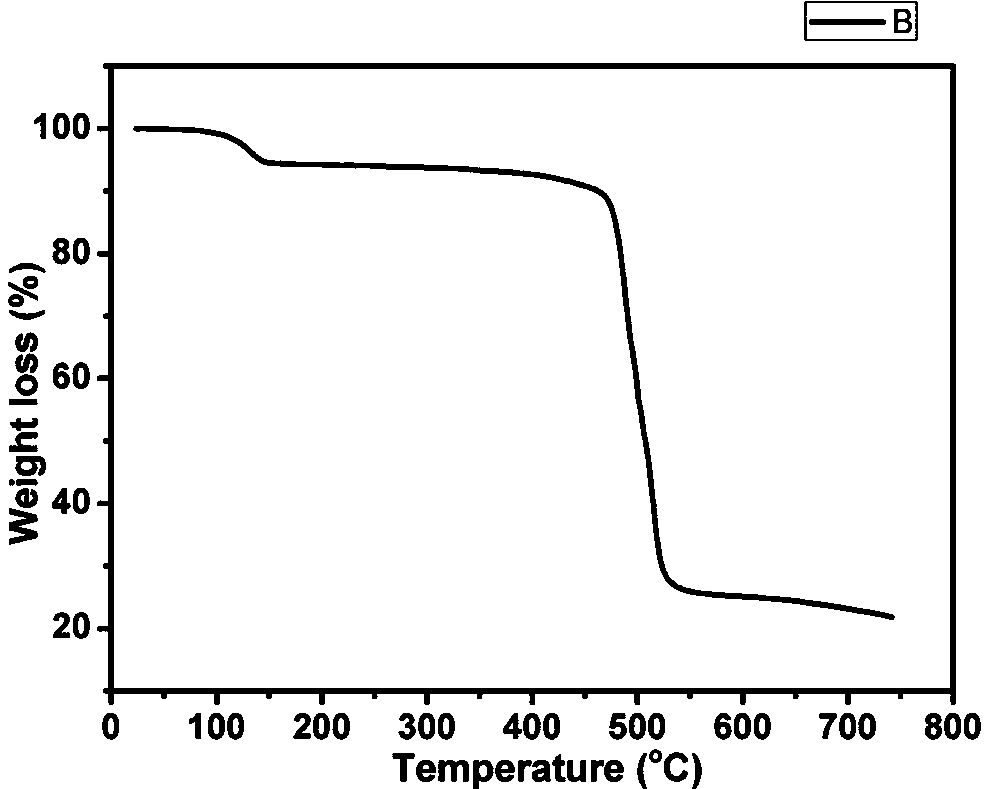Eu (III)-metal-organic framework and preparation and application methods thereof
A metal-organic framework, Å technology, applied in the field of fluorescent probes, can solve the problem of less Ln-MOFs, and achieve the effect of low cost, improved fluorescence activity and high purity
- Summary
- Abstract
- Description
- Claims
- Application Information
AI Technical Summary
Problems solved by technology
Method used
Image
Examples
Embodiment 1
[0034] Example 1. Preparation of Eu(Ⅲ)-MOF:
[0035] Accurately weigh 0.0243g (0.1mmol) 3-4-(carboxyphenyl)-6-carboxypyridine (H 2 cppc) was dissolved in 6mL DMF, CH 3 CN and H 2 O (V:V:V=3:2:1) mixed solvent, pipette 1mL Eu(NO 3 ) 3 ·6H 2 O (0.1mol / L) aqueous solution in the above mixed solvent, the mixture was magnetically stirred at room temperature for 15min, then 20 microliters of 4M HCl was added dropwise; Reacted for 3 days, and finally cooled to room temperature at 5°C / hour to obtain colorless rod-shaped crystals, which were filtered, washed and collected to obtain a metal organic framework compound.
[0036] The 3-4-(carboxyphenyl)-6-carboxypyridine (H 2 cppc) is a well-known substance in the art, and 3-4-(carboxyphenyl)-6-carboxypyridine (H in the present invention) 2 cppc) was purchased from Jinan Henghua Chemical Co., Ltd.
Embodiment 2
[0037] Example 2, Eu(Ⅲ)-metal-organic framework crystallographic structure parameters
[0038] The Eu(III)-MOF crystal structure obtained in Example 1 was determined as follows: a single crystal with a suitable size was selected under a microscope for X-ray single crystal structure analysis. The X-ray diffraction data of the crystals were collected by a German Bruker Smart-Apex CCD surface detection X-ray single crystal diffractometer, and the Mo-Kα target, measured at room temperature. Data reduction and structural elucidation were performed using the SHELXTL-97 program. The main crystallographic data of the organic frameworks are listed in Table 1.
[0039] Table 1. Crystallographic structural parameters of organic frameworks
[0040]
Embodiment 3
[0041] Example 3. Experimental operation of Eu(Ⅲ)-metal-organic framework fluorescence detection in organic solvents:
[0042] Accurately weigh 0.5 mg of Eu(Ⅲ)-MOF sample powder and disperse in 4.00 mL of acetonitrile (CH 3 CN), Methanol (CH 3 OH), dichloromethane (CHCl 2 ), ethanol (C 2 h 5 OH), N,N-dimethylacetamide (DMA), N,N-dimethylformamide (DMF), n-hexane (C 6 h 14 ), formaldehyde (HCHO), H 2 O, n-butanol (C 4 h 9 OH), chloroform (CHCl 3 ), benzene (C 6 h 6 ), tetrahydrofuran (THF), and pentachloronitrobenzene (PCNB) in acetonitrile solution, after ultrasonic vibration for 30 min, dispersions in different solvents were obtained. After the configuration is complete, in λ ex =275nm excitation wavelength, respectively measure the fluorescence spectrum of the corresponding dispersion. From the emission spectrum ( Figure 6 , 7 ) shows that solvent molecules have a very obvious effect on the luminescence intensity of the complex, and the order of fluorescence ...
PUM
 Login to View More
Login to View More Abstract
Description
Claims
Application Information
 Login to View More
Login to View More - R&D
- Intellectual Property
- Life Sciences
- Materials
- Tech Scout
- Unparalleled Data Quality
- Higher Quality Content
- 60% Fewer Hallucinations
Browse by: Latest US Patents, China's latest patents, Technical Efficacy Thesaurus, Application Domain, Technology Topic, Popular Technical Reports.
© 2025 PatSnap. All rights reserved.Legal|Privacy policy|Modern Slavery Act Transparency Statement|Sitemap|About US| Contact US: help@patsnap.com



